At Subul Cargo, we recognize the crucial role that reliable sea freight plays in the global supply chain. Our Full Sea Shipping service is meticulously designed to meet the needs of businesses looking to transport large volumes of goods efficiently and securely across the globe. We connect you to major ports worldwide, ensuring that no matter where your destination lies—be it Europe, Asia, the Americas, Africa, or Australia—your cargo arrives safely and on time.
What is Full Sea Shipping?

Full Sea Shipping, also known as Full Container Load (FCL) shipping, is a method of transporting goods by sea where an entire container is utilized for a single shipment. This approach is ideal for businesses and individuals who need to ship large volumes of cargo, allowing them to use the full capacity of the container for their goods. Here’s a closer look at what Full Sea Shipping entails:
Advantages of Full Sea Shipping With Subul Cargo
- Lower cost (per container): Full Sea Shipping is one of the most cost-effective methods for transporting large volumes of goods over long distances. Due to the economies of scale achieved by shipping vast quantities of cargo at once, the per-unit cost of transportation is significantly reduced compared to air freight or road transport.
- Suitable for large shipments: Sea freight offers unmatched capacity for large and heavy shipments. Whether you’re transporting bulk commodities, oversized machinery, or large quantities of consumer goods, Full Sea Shipping can accommodate your needs with ease. Container ships are designed to handle substantial loads, making them ideal for large-scale logistics operations.
- Flexibility in Cargo Types: Full Sea Shipping can handle a diverse range of cargo types, including perishable goods, hazardous materials, and oversized items. Specialized containers, such as refrigerated units and open-top containers, ensure that various types of cargo are transported safely and efficiently.
- Environmental Impact: Shipping by sea is more environmentally friendly compared to other modes of transport, such as air freight. Modern container ships are designed to be fuel-efficient, reducing greenhouse gas emissions per ton of cargo transported. This makes Full Sea Shipping an attractive option for companies looking to minimize their carbon footprint.
- Global Reach: Full Sea Shipping services provide extensive global coverage, connecting major ports around the world. This extensive network ensures that goods can be transported to virtually any destination, facilitating international trade and supply chain operations.
- Reliability and Predictability: Sea freight schedules are highly reliable, with regular departures and well-established routes. This predictability allows businesses to plan their logistics operations with confidence, ensuring that goods arrive on time to meet production schedules and customer demands.
- Enhanced Security: Modern shipping practices and advanced tracking technologies ensure the security of cargo during transit. Containers are sealed and monitored throughout their journey, reducing the risk of theft or damage. Additionally, comprehensive insurance options provide further peace of mind.
Disadvantages of the Full Sea Shipping:
While Full Sea Shipping (FCL) offers numerous benefits, it also comes with some disadvantages. Here are the key challenges associated with this shipping method:
- Higher Costs for Smaller Shipments: Full Sea Shipping is most cost-effective for large shipments that can fill an entire container. For smaller shipments, the cost can be prohibitively high because the shipper is paying for the entire container, regardless of how much space is actually used. This makes FCL less economical for businesses with lower volume shipments.
- Longer Transit Times: Sea shipping generally takes longer than other modes of transportation, such as air freight. Depending on the route and destination, transit times can range from several weeks to a couple of months. This longer duration can be a significant drawback for businesses that need to move goods quickly or have tight delivery schedules.
- Limited Flexibility: Once a container is loaded and shipped, it can be difficult to make changes to the shipment. Unlike smaller shipments that can be rerouted or expedited more easily, a full container load is less flexible. This can be problematic if there are changes in demand or unforeseen issues that require adjustments to the shipping plan.
When to Choose Full Container Load
If you have a large volume of goods that can fill an entire container, FCL is the best choice. This method maximizes the use of the container space, leading to more efficient shipping and better cost per unit.
Even though the upfront cost for an FCL shipment might be higher, it becomes more cost-effective when you are shipping enough goods to fill the container. The cost savings per unit can be significant compared to shipping smaller quantities multiple times.
FCL offers greater security for high-value or sensitive cargo since your goods are the only items in the container. This reduces the risk of damage, theft, or contamination that can occur when sharing a container with other shipments.
For businesses with regular, large shipments, FCL provides a predictable and consistent shipping schedule. This can improve supply chain reliability and planning, ensuring that inventory levels are maintained without delays.
In the partial sea shipping, your goods are consolidated with other shipments, which can lead to delays if other shippers are not ready. With FCL, you avoid such delays as the container moves as soon as it is loaded.





